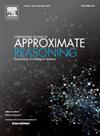Fusing fuzzy rough sets and mean shift for anomaly detection
IF 3
3区 计算机科学
Q2 COMPUTER SCIENCE, ARTIFICIAL INTELLIGENCE
引用次数: 0
Abstract
Outlier detection is a critical but challenging task due to the complex distribution of practical data, and some Fuzzy Rough Sets (FRS)-based methods have been presented to identify outliers from these data. However, these methods still have limitations when facing the co-existence of different types of outliers. In this study, an improved FRS-based unsupervised anomaly detection method is proposed by integrating distance and density information. Specifically, to detect the local outliers, a fuzzy granule density is first defined by introducing a Gaussian kernel similarity to characterize the local density of samples. Then, optimistic and pessimistic fuzzy granule densities are further developed to evaluate the density variation in the local neighborhood. Moreover, a distance measure based on mean shift is introduced to detect global and group outliers. Finally, an outlier detection method that integrates the density and distance measures is designed to effectively identify diverse types of outliers. Extensive experiments on synthetic and public datasets, along with statistical significance analysis, demonstrate the superior performance of the proposed method, achieving an average improvement of at least 12.27% in terms of AUROC.
基于模糊粗糙集和均值移位的异常检测
由于实际数据的复杂分布,异常值检测是一项关键但具有挑战性的任务,一些基于模糊粗糙集(FRS)的方法已经提出了从这些数据中识别异常值的方法。然而,这些方法在面对不同类型离群值共存时仍然存在局限性。本文提出了一种改进的基于frs的无监督异常检测方法,将距离和密度信息相结合。具体来说,为了检测局部异常值,首先通过引入高斯核相似度来定义模糊颗粒密度来表征样本的局部密度。然后,进一步发展乐观和悲观模糊颗粒密度来评价局部邻域的密度变化。此外,还引入了一种基于均值位移的距离度量来检测全局异常点和组异常点。最后,设计了一种融合密度和距离测度的离群点检测方法,有效识别不同类型的离群点。在合成和公共数据集上进行的大量实验以及统计显著性分析表明,所提出的方法具有优越的性能,在AUROC方面平均提高了至少12.27%。
本文章由计算机程序翻译,如有差异,请以英文原文为准。
求助全文
约1分钟内获得全文
求助全文
来源期刊

International Journal of Approximate Reasoning
工程技术-计算机:人工智能
CiteScore
6.90
自引率
12.80%
发文量
170
审稿时长
67 days
期刊介绍:
The International Journal of Approximate Reasoning is intended to serve as a forum for the treatment of imprecision and uncertainty in Artificial and Computational Intelligence, covering both the foundations of uncertainty theories, and the design of intelligent systems for scientific and engineering applications. It publishes high-quality research papers describing theoretical developments or innovative applications, as well as review articles on topics of general interest.
Relevant topics include, but are not limited to, probabilistic reasoning and Bayesian networks, imprecise probabilities, random sets, belief functions (Dempster-Shafer theory), possibility theory, fuzzy sets, rough sets, decision theory, non-additive measures and integrals, qualitative reasoning about uncertainty, comparative probability orderings, game-theoretic probability, default reasoning, nonstandard logics, argumentation systems, inconsistency tolerant reasoning, elicitation techniques, philosophical foundations and psychological models of uncertain reasoning.
Domains of application for uncertain reasoning systems include risk analysis and assessment, information retrieval and database design, information fusion, machine learning, data and web mining, computer vision, image and signal processing, intelligent data analysis, statistics, multi-agent systems, etc.
 求助内容:
求助内容: 应助结果提醒方式:
应助结果提醒方式:


